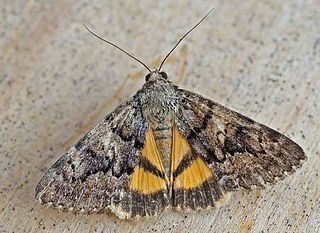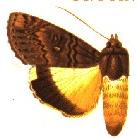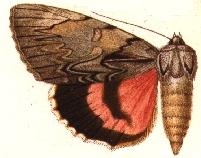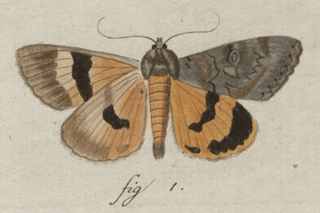
Catocala is a generally Holarctic genus of moths in the family Erebidae. The genus was erected by Franz von Paula Schrank in 1802. The moths are commonly known as underwing moths or simply underwings. These terms are sometimes used for a few related moths, but usually – especially when used in plural, not as part of a species name – they are used to refer to Catocala only.

Acontiinae is a subfamily of bird dropping moths in the family Noctuidae. There are more than 50 genera and 430 described species in Acontiinae, found worldwide in temperate and tropical climates.
Cyme is a genus of moths in the family Erebidae. The genus was described by Felder in 1861.

Catocala fulminea, the yellow bands underwing, is a moth of the family Erebidae. The species was first described by Giovanni Antonio Scopoli in his 1763 Entomologia Carniolica. It is found in central and southern Europe, east Asia and Siberia. The xarippe lineage has been proposed to be a distinct and valid species in its own right, instead of being only subspecifically distinct.

Erebus is a genus of moths in the family Erebidae.

Catocala nymphaea is a species of moth of the family Erebidae. It was described by Eugenius Johann Christoph Esper in 1787. It is found in southern France, Austria, Albania, Portugal, Croatia, Italy, Greece, Corsica, Sicily, Crete, North Africa, Anatolia, Afghanistan and Kashmir.

Herpetogramma is a genus of moths in the family Crambidae described by Julius Lederer in 1863. It currently comprises 106 species that are found in North America, Eurasia, Australia, New Zealand, Central and South America. Of the few species where host plants are known, the larvae mostly feed on grasses.

Metasia is a genus of moths of the family Crambidae.

Ulotrichopus is a genus of moths in the family Erebidae. The genus was described by Wallengren in 1860.

Mocis is a genus of moths in the family Erebidae. The genus was erected by Jacob Hübner in 1823.

Catocala leechi is a moth of the family Erebidae first described by George Hampson in 1913. It is found in Kashmir.

Catocala fuscinupta is a moth of the family Erebidae first described by George Hampson in 1913. It is found in Himachal Pradesh, India.

Catocala musmi is a moth of the family Erebidae first described by George Hampson in 1913. It is found in China and Korea.

Catocala flavescens is a moth of the family Erebidae first described by George Hampson in 1894. It is found in India.
Ulotrichopus rama is a moth of the family Erebidae first described by Frederic Moore in 1885. It is found on Sumatra, Flores and Sri Lanka.

The Erebinae are a subfamily of moths in the family Erebidae erected by William Elford Leach in 1815. Erebine moths are found on all continents except Antarctica, but reach their greatest diversity in the tropics. While the exact number of species belonging to the Erebinae is not known, the subfamily is estimated to include around 10,000 species. Some well-known Erebinae include underwing moths (Catocala) and witch moths (Thermesiini). Many of the species in the subfamily have medium to large wingspans, up to nearly 30 cm in the white witch moth, which has the widest wingspan of all Lepidoptera. Erebine caterpillars feed on a broad range of plants; many species feed on grasses and legumes, and a few are pests of castor bean, sugarcane, rice, as well as pistachios and blackberries.
Catocala detrita is a moth in the family Erebidae first described by Warren in 1913. It is found in the Ural Mountains of Russia.
Catocala distorta is a moth in the family Erebidae. It was described by Arthur Gardiner Butler in 1889. It is found in Himachal Pradesh, India. The species is 52 millimetres (2.0 in) long and is different from Catocala nymphaea by being more brown and having much duller thorax and forewing.

Catocala neonympha is a moth in the family Erebidae first described by Arthur Gardiner Butler in 1877. It is found in south-western Russia, Ukraine, Kazakhstan, eastern Turkey, Iraq, Armenia, Kurdistan, Afghanistan, the Altai Mountains and southern Siberia.









